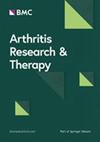银屑病关节炎中多重b/tsDMARD失败的负担和决定因素
IF 4.9
2区 医学
Q1 Medicine
引用次数: 0
摘要
尽管银屑病关节炎(PsA)的治疗取得了重大进展,但许多患者并没有通过多种生物(b)或靶向合成(ts)- dmard实现缓解和循环。确定重复性治疗失败的潜在原因仍然是一个知识缺口。在这里,我们描述了纽约大学银屑病关节炎中心患有多发性b/tsDMARD失败的PsA患者的处方模式和特征。960名PsA患者被纳入观察性纵向登记。收集人口统计学、病史、用药情况和银屑病表型。多b/tsDMARD失效定义为需要≥4 b/tsDMARD。725例患者(75%)在病程中使用≥1 b/tsDMARD。最初的b/tsDMARDs处方主要是抗tnf药物。166例(17%)患者出现multi-b/tsDMARD失败。与需要1 b/tsDMARD的患者相比,女性(OR 2.3;95%CI 1.4-3.8),轴性疾病(OR 2.1;95% CI 1.2-3.6),抑郁(OR 2.0;95%CI 1.1-3.7)和肥胖(OR 1.7;在调整了年龄、病程、性别、抑郁、吸烟、肥胖和皮肤严重程度后,95%CI 1.0-2.8)是多b/tsDMARD衰竭的危险因素。多b/tsDMARD PsA失败的患者在临床就诊时也有疾病活动性增加(即关节计数肿胀,p = 0.005)。在该队列中,17%的PsA患者经历了multi-b/tsDMARD失败。这些患者更可能是女性,肥胖,有较高的轴向受累和抑郁率,以及较高的活动性疾病活动性。这突出了多重治疗失败的炎症和非炎症驱动因素,强调了PsA患者需要精确医学策略和潜在的非药物辅助治疗来改善预后和生活质量。本文章由计算机程序翻译,如有差异,请以英文原文为准。
Burden and determinants of multi-b/tsDMARD failure in psoriatic arthritis
Despite significant therapeutic advances in psoriatic arthritis (PsA), many patients do not achieve remission and cycle through multiple biologic (b)- or targeted synthetic (ts)- DMARDs. Identifying the underlying reasons for repetitive therapeutic failure remains a knowledge gap. Here we describe prescribing patterns and characteristics of PsA patients with multi-b/tsDMARD failure at the NYU Psoriatic Arthritis Center. Nine hundred sixty PsA patients were enrolled in an observational, longitudinal registry. Demographics, medical history, medication use, and psoriatic disease phenotype were collected. Multi-b/tsDMARD failure was defined as requiring ≥ 4 b/tsDMARDs. Seven hundred twenty-five patients (75%) used ≥ 1 b/tsDMARD during their disease course. The initial b/tsDMARDs prescribed were predominately anti-TNF agents. 166 (17%) patients had multi-b/tsDMARD failure. Compared to those requiring 1 b/tsDMARD, female sex (OR 2.3; 95%CI 1.4–3.8), axial disease (OR 2.1; 95% CI 1.2–3.6), depression (OR 2.0; 95%CI 1.1–3.7), and obesity (OR 1.7; 95%CI 1.0–2.8) were risk factors for multi-b/tsDMARD failure disease after adjustment for age, disease duration, sex, depression, smoking, obesity, and skin severity. Patients with multi-b/tsDMARD failure PsA also had increased disease activity at their clinical visit (i.e., swollen joint count, p = 0.005). In this cohort, 17% patients with PsA experienced multi-b/tsDMARD failure. These patients were more likely to be female, obese, and have higher rates of axial involvement and depression, along with higher active disease activity. This highlights the inflammatory and non-inflammatory drivers of multiple therapeutic failures, underscoring the need for precision medicine strategies and potential non-pharmacologic adjuvant therapies for patients with PsA to improve outcomes and quality of life.
求助全文
通过发布文献求助,成功后即可免费获取论文全文。
去求助
来源期刊

Arthritis Research & Therapy
RHEUMATOLOGY-
CiteScore
8.60
自引率
2.00%
发文量
261
审稿时长
14 weeks
期刊介绍:
Established in 1999, Arthritis Research and Therapy is an international, open access, peer-reviewed journal, publishing original articles in the area of musculoskeletal research and therapy as well as, reviews, commentaries and reports. A major focus of the journal is on the immunologic processes leading to inflammation, damage and repair as they relate to autoimmune rheumatic and musculoskeletal conditions, and which inform the translation of this knowledge into advances in clinical care. Original basic, translational and clinical research is considered for publication along with results of early and late phase therapeutic trials, especially as they pertain to the underpinning science that informs clinical observations in interventional studies.
 求助内容:
求助内容: 应助结果提醒方式:
应助结果提醒方式:


